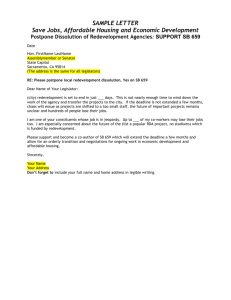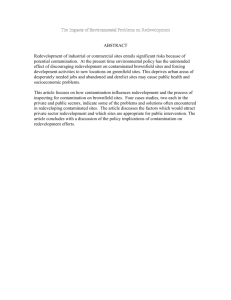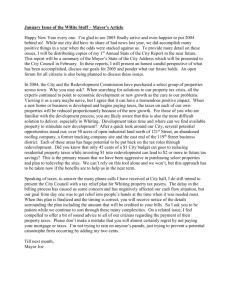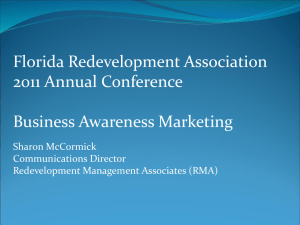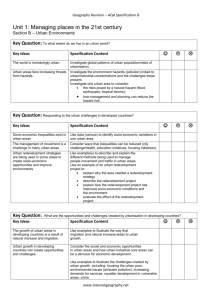Economic Development and Redevelopment
advertisement
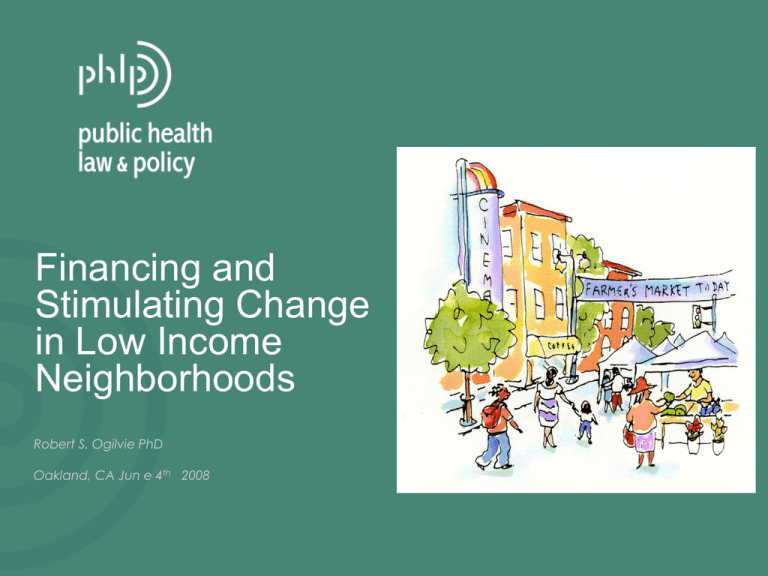
Financing and Stimulating Change in Low Income Neighborhoods Robert S. Ogilvie PhD Oakland, CA Jun e 4th 2008 Economic Development Strategies Economic Development Institutions Local Government Economic Development Small Business Assistance Agencies Economic Development Corporations Community Development Corporations Job Training and Placement Agencies Business Organizations Agencies Economic Development Financing Sources Local Government State Government Federal Government Community Development Financial Institutions Private Foundations Private Banks Financial Markets Three to focus on for bringing healthy food to low income neighborhoods Redevelopment Community Development Block Grants New Market Tax Credits What is Redevelopment? Redevelopment is a public process that aims to improve the economic and physical condition of a designated (blighted) area Blight: dilapidated, vacant and abandoned buildings, and concentrated economic inactivity Redevelopment agencies can declare blighted areas as redevelopment areas. Powers of the Redevelopment Agency 1. 2. 3. 4. 5. Tax increment financing Eminent domain Improve blighted conditions Master planning authority Mobilize other public funds to incentivize neighborhood improvement behaviors Note: the budget of the Redevelopment Agency is separate from the city/county budget (This is critically important in California given the structural fiscal squeeze that most local governments operate under.) What is Blight? There are two types of blight according to California redevelopment law: 1.physical blight 2.economic blight Physical blight defined Buildings that are unsafe or unhealthy for persons to live or work. Economic blight defined Serious residential overcrowding ... An excess of bars, liquor stores, or adult-oriented businesses that has resulted in significant public health, safety, or welfare problems. A high crime rate that constitutes a serious threat to the public safety and welfare. Tax Increment Financing (TIF) $80.00 $70.00 $60.00 $50.00 $40.00 $30.00 Taxes Increment Collected by the Redevelopment Agency $20.00 $10.00 Base Year Value $Year 1 Year 3 Year 6 Year 9 Year 12 Year 15 Year 18 Year 21 Year 24 Year 27 Year 30 Limited powers Economic Development & Redevelopment haven’t been able to stem the changes in the economy brought on by globalization Economic Development & Redevelopment have been able to make targeted changes in many neighborhoods around the country, however. Limited reach Redevelopment agencies cannot do any developing Redevelopment agencies can’t fund programs Redevelopment agencies build infrastructure and give incentives to private developers to build in redevelopment areas Redevelopment continued: (Eminent Domain) Eminent domain is the inherent power of the state to seize a citizen's private property for a public use. When property is “taken” for the just compensation must be paid. The Fillmore – San Francisco Redevelopment continues to be controversial Redevelopment agencies turn the seized property over to private developers Opponents say that this favors the interests of wealthy redevelopers over those of small business owners and individual home owners. Many redevelopment agencies have decided to renounce the use of eminent domain over residential property Kelo v. New London (CT) Community Development Block Grants Federal categorical funding awarded to cities and rural areas by the Department of Housing and Urban Development Allocated at the discretion of state and local governments What you can use CDBG funds for Real estate acquisition, relocation, demolition, Rehabilitation of housing and commercial buildings Building and improving public facilities & neighborhood centers Public services Economic development and job creation/retention activities CDBG eligibility To be eligible applicants must identify urgent needs of the community, and solicit project ideas and plans from citizens and local organizations that address those needs New Market Tax Credits A federal tax initiative administered by the Department of Treasury’s CDFI Fund Designed to stimulate private investment capital into underserved markets in certain census tracts o o 80% of applicable area median income 20% poverty The business must be connected to low-income people o Customers / clients o Employees o Owners Places where NMTCs can be used Empowerment Zones, Enterprise Communities or Renewal Communities Brownfields Encompassed by a HOPE VI redevelopment plan Federally designated as Native American or Alaskan Native areas, Hawaiian Homelands, or redevelopment areas by Tribal or other authority Colonias areas as designated by HUD State or local tax-increment financing districts, enterprise zones programs, or other similar state / local programs Certain counties designated by FEMA Eligible Uses of NMTCs Can be applied to a wide range of economic development and business activities o Commercial real estate o Community facilities o Childcare facilities o Charter schools o Health-care facilities o Business financing o supermarkets NMTCs & Housing Home ownership real estate developments are permitted Ownership & operation of rental housing is specifically excluded o Mixed-use projects are permissible if less than 80% of gross revenue is from dwelling units (or if the project is separated into residential and nonresidential components) General NMTC Structure CDFI Fund NMTC Award Reporting Payments & Distributions / Interest NMTC & Investment Returns Investor No return of principal for 7 years Cash Equity QEI QALICB = Qualified Active Low-Income Community Business QLICI = Qualified Low-Income Community Investment CDE 85% of proceeds must remain in QALICB’s during first 6 years, 75% in 7th QLICI, i.e. Equity Investment, Loan CDE / QALICB Clearing land for Smart Growth Development New affordable housing Mixed-Use / Smart Growth developments What redevelopment, CDBG funds, & NMTCs can be used for Attracting grocery stores to low-income neighborhoods Rehabilitating Brownfields Rehabilitating brownfields Improving air quality Increasing opportunities for physical activity How you can influence redevelopment Redevelopment is a public process, and state law requires public participation in the planning and approval of redevelopment plans. Participation usually happens through the venue of the Project Area Committee (PAC), which is an elected body. (In many communities this is the minimum) Pursue community benefits agreements. (These can include living wage policies, local hire ordinances.) Funding Healthy Food Retail Many potential funding sources But…health is usually not an explicit priority Programs lack coordination, can be highly technical, and are subject to budgetary fluctuation. How can public funding sources be used? To conduct feasibility studies or market analysis To influence the behavior of the private sector To incentivize good corporate citizenship (fair labor practices, healthy foods) To bridge the financial gap on complex development projects Potential Economic Development Strategies for Securing Healthy Food in a Neighborhood Supermarket Development o Build a new full service supermarket Small Store Development o Build new produce markets or small format groceries Corner Store Improvement o Identify corner store operators willing to offer fresh food for sale in existing stores Mobile Markets o Organize the sale of fresh produce from trucks with a weekly schedule Farmers Markets o Organize weekly market Local farmers A USDA grant helped the Rainbow Farmers Cooperative develop a business marketing plan Farmers Markets El Dorado County funded a farmers market feasibility study with Community Development Block Grant (CDBG) funds How can public funding sources be used? To conduct feasibility studies or market analysis To influence the behavior of the private sector To incentivize good corporate citizenship (fair labor practices, healthy foods) To bridge the financial gap on complex development projects Supermarket First grocery store in downtown LA since 1947 will open in summer 2008 with an investment from CalPERS. How can public funding sources be used? To conduct feasibility studies or market analysis To influence the behavior of the private sector To incentivize good corporate citizenship (fair labor practices, healthy foods) To bridge the financial gap on complex development projects Corner Stores City Produce received a small business improvement loan from the SF Redevelopment Agency How can public funding sources be used? To conduct feasibility studies or market analysis To influence the behavior of the private sector To incentivize good corporate citizenship (fair labor practices, healthy foods) To bridge the financial gap on complex development projects Public Markets Midtown Global Market in Minneapolis used tax credits to develop a 80,000 sq ft public market with 50 local vendors Summary Economic Development resources can be used to: Conduct feasibility studies or market analysis Influence the behavior of the private sector Incentivize corporate citizenship Bridge the financial gap on complex or risky development projects Gaps in funding Explore policy opportunities But consider fiscal context Link carrots and sticks For example, limit location of mobile vendors except where selling healthy items Good governance practices For example, allow expedited review for healthy food retail Attracting economic development resources to a project Participate in General Plan & Redevelopment Plan updates This is a political process Collect & share data Involve the community Engage elected and appointed officials Work across sectors Uses funds from many sources UNIVERSITY STRONG NEIGHBORHOOD - Park 6th & Williams o $689,000 – SJRA (park) o $70,000 – D3 PDO fees (wall) o $70,000 – NRS funds(gazebo) o $900,000 –CDBG(acquisition) www.healthyplanning.org Database of healthy food retail funding programs Toolkit on Economic Development and Redevelopment Quarterly newsletter on healthy planning and economic development Contact us: Planning for Healthy Places Public Health Law & Policy (510) 302-3308 info@healthyplanning.org www.healthyplanning.org
